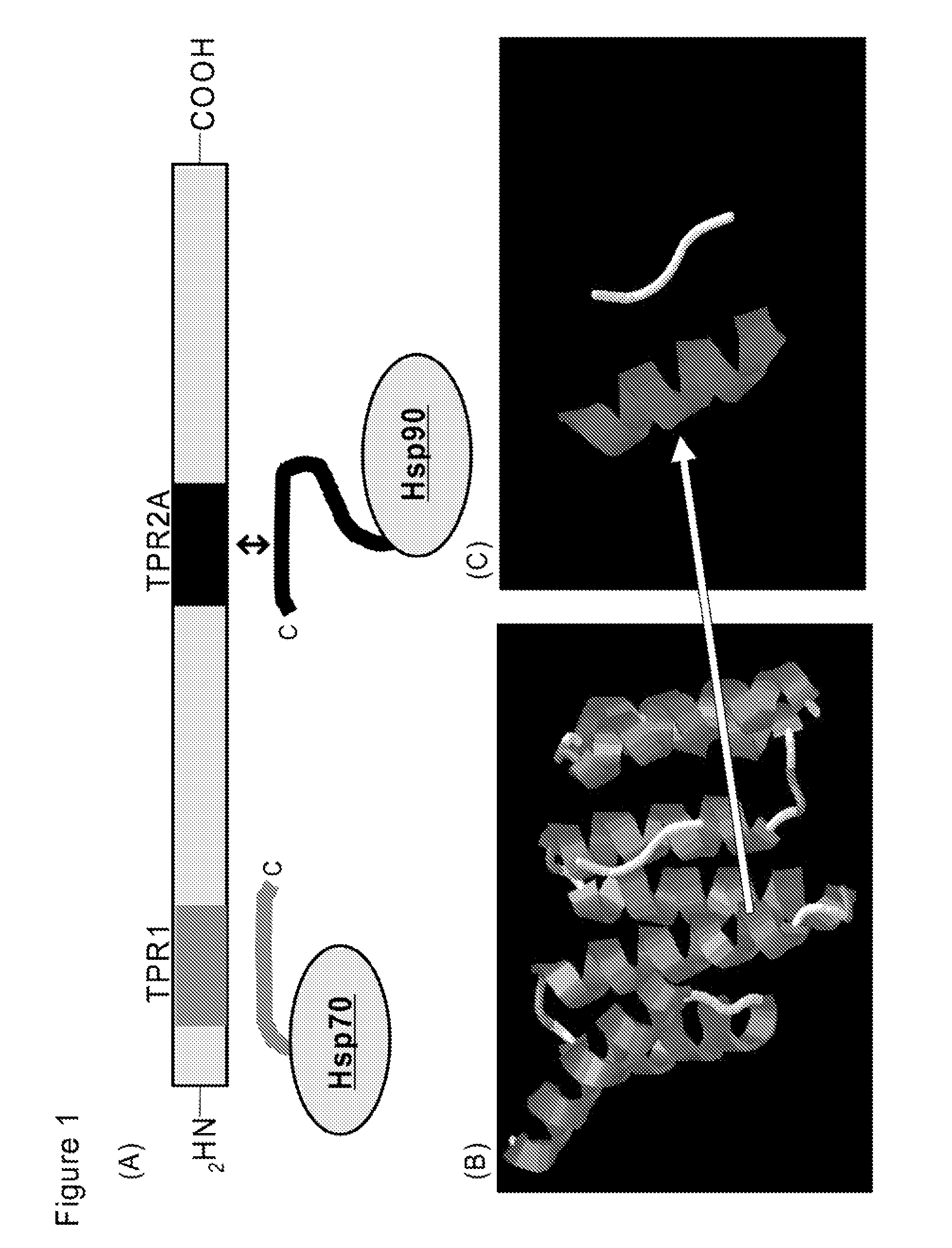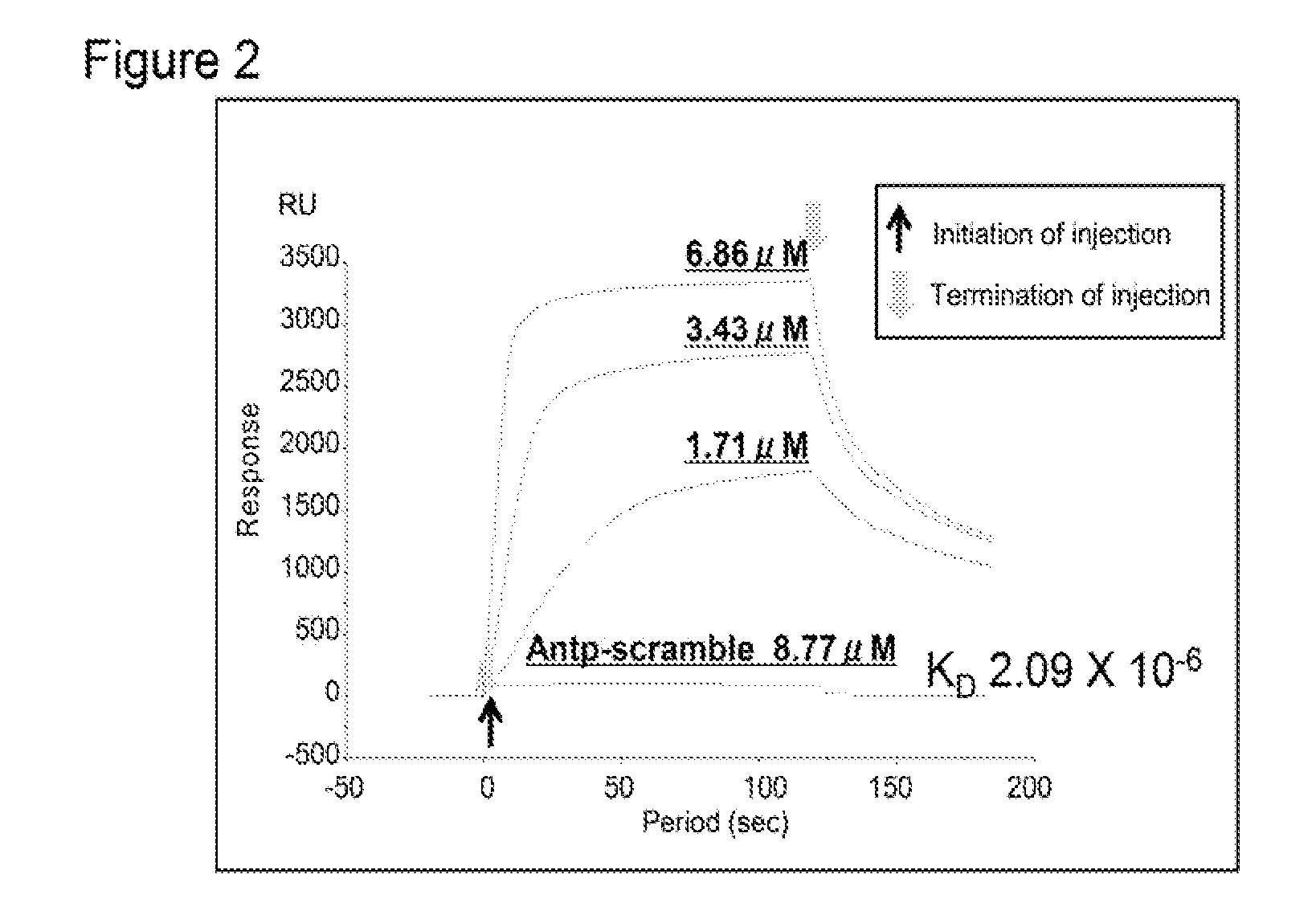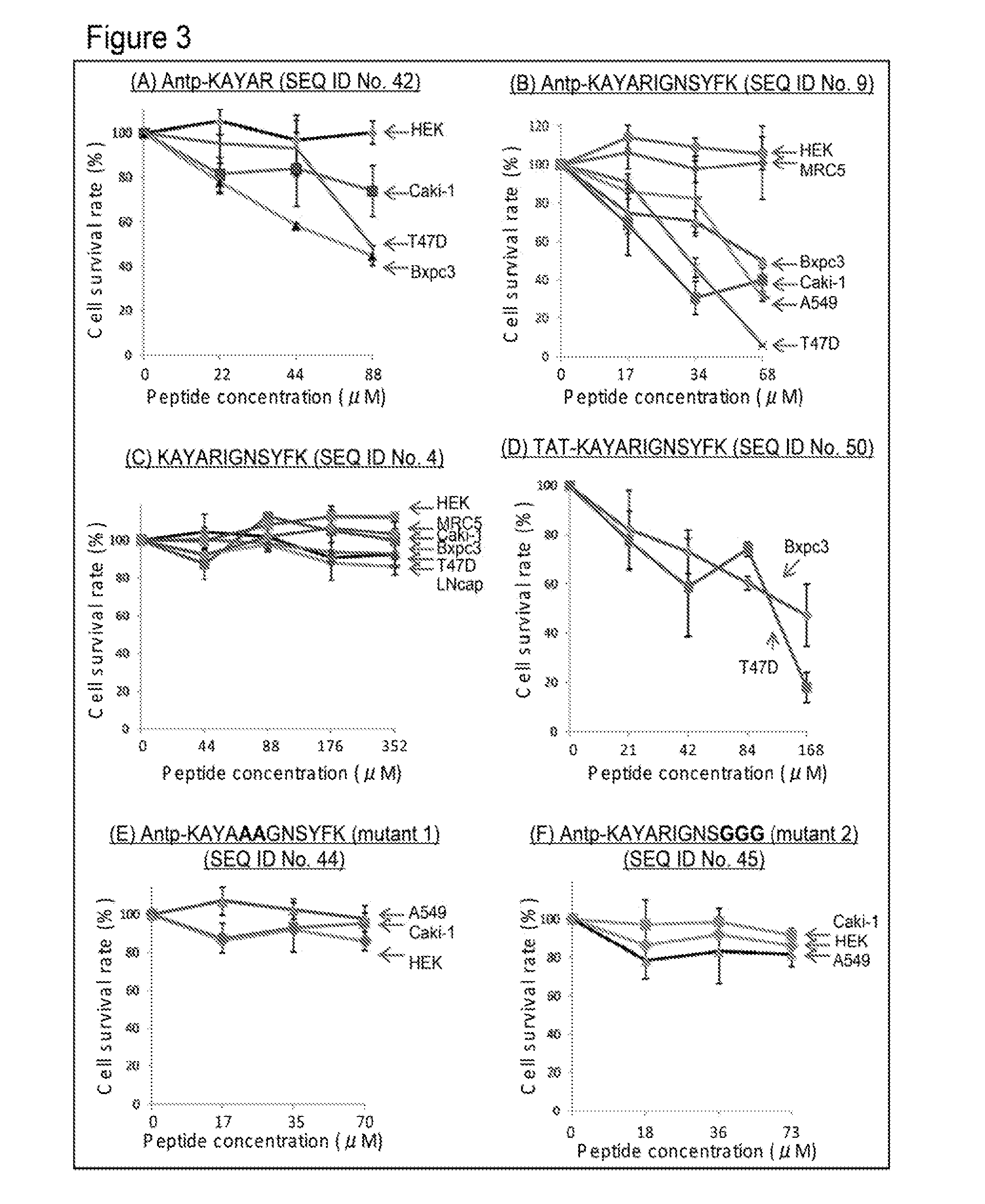Hsp9O-targeted anti-cancer chimeric peptide
a chimeric peptide and anti-cancer technology, applied in the direction of depsipeptides, peptide/protein ingredients, fusion polypeptides, etc., can solve the problems of side effects, inhibit the protein function of the compound, interfere with the efficient penetration of the medicine into the tumor mass in the human body, etc., to achieve high selectiveness of cancer cells, maintain cell stability, and not have adverse effects
- Summary
- Abstract
- Description
- Claims
- Application Information
AI Technical Summary
Benefits of technology
Problems solved by technology
Method used
Image
Examples
example 1
Production of Hsp90 TPR-Binding Peptide-Antp Chimeric Peptide and Measurement of Biological Activity
[0401]It was examined whether the chimeric peptide according to the present invention has a cell-killing effect and an anti-tumor effect to solid cancer cell strains.
(Materials and Methods)
[0402](Cell Strains)
[0403]Human breast cancer cell strains (BT-20 and T47D), lung cancer cell strains (H322 and H460), a prostate cancer cell strain (LNCap), a neuroglioma cell strain (U251), a kidney cancer cell strain (Caki-1) and a lung fibroblast cell strain (MRC-5) were purchased from American Type Culture Collection (Manassas, Va.). A human pancreatic cancer cell strain (BXPC-3) was purchased from European Collection of Cell Cultures (ECACC; Salisbury, Wiltshire, UK). A human embryonic kidney cell strain (HEK293) was purchased from RIKEN Cell Bank (Tsukuba, Japan). The cells were cultured in RPMI 1640 (BT-20, T47D, H322, H460, LNCap, U251 and BXPC-3), MEM (MARC-5) or D-MEM (HEK293, Caki-1) eac...
example 2
Comprehensive Analysis of the TPR Domain-Binding Peptides
[0446]In the present Example, an experiment was performed to determine whether the analogues of the Hsp90 TPR domain-binding peptide (amino acid sequence X1X2X3X4X5X6X7X8X9X10X11X12 (SEQ ID NO: 1); wherein:
[0447]X1 is K, R or A;
[0448]X2 is A or G;
[0449]X3 is Y or L;
[0450]X4 is A or G;
[0451]X5 is R, A or K;
[0452]X6 is I or R;
[0453]X7 is G or A;
[0454]X8 is N or Q;
[0455]X9 is S or Y;
[0456]X10 is Y or S;
[0457]X11 is F or Y;
[0458]X12 is K or R, or
[0459]Antp-TPR slong (Antp-RQIAKAYARIGNSYFKEEKYK; SEQ ID NO: 39), which was obtained by elongation of the TPR peptide), could be used. An experiment using peptide in which R11 was used in place of TPR was also performed.
[0460]All protocols were in accordance with those in Example 1, except that the peptide sequence was different. Peptides used include the following:
[0461]
SEQ ID No. 9:RQIKIWFQNRRMKWKKKAYARIGNSYFK (Antp-wild)SEQ ID No. 10:RQIKIWFQNRRMKWKKRAYARIGNSYFK (Antp-K1R)SEQ ID No. 11:...
example 3
Test of Other Cell-Penetrating Peptides
[0487]In the present Example, it was investigated whether cell-penetrating peptides other than the Antp peptides could be used.
[0488]The peptides used include the following: All protocols were in accordance with those in Example 1, except that the peptide sequences of the cell-penetrating peptides were different.
[0489]Specifically, an experiment was performed by using Antp-TPR slong (Antp-RQIAKAYARIGNSYFKEEKYK; SEQ ID NO: 39), which was obtained by elongation of the TPR peptide, and the peptide in which R11 (RRRRRRRRRRR; SEQ ID NO: 7) was used in place of TPR.
[0490]All protocols were in accordance with those in Example 1, except that the peptide sequences of the cell-penetrating peptides were different.
[0491]
YGRKKRRQRRR(TAT SEQ ID No. 6)RRRRRRRRRRR(R11 SEQ ID No. 7)
[0492]The sequences produced are the followings:
[0493]
R11-TPR (RRRRRRRRRRRKAYARIGNSYFK;)SEQ ID No. 40TAT-TPR (YGRKKRRQRRRKAYARIGNSYFK;)SEQ ID No. 50
(Results)
[0494]The results obtaine...
PUM
| Property | Measurement | Unit |
|---|---|---|
| temperature | aaaaa | aaaaa |
| temperature | aaaaa | aaaaa |
| temperature | aaaaa | aaaaa |
Abstract
Description
Claims
Application Information
 Login to View More
Login to View More - R&D
- Intellectual Property
- Life Sciences
- Materials
- Tech Scout
- Unparalleled Data Quality
- Higher Quality Content
- 60% Fewer Hallucinations
Browse by: Latest US Patents, China's latest patents, Technical Efficacy Thesaurus, Application Domain, Technology Topic, Popular Technical Reports.
© 2025 PatSnap. All rights reserved.Legal|Privacy policy|Modern Slavery Act Transparency Statement|Sitemap|About US| Contact US: help@patsnap.com



